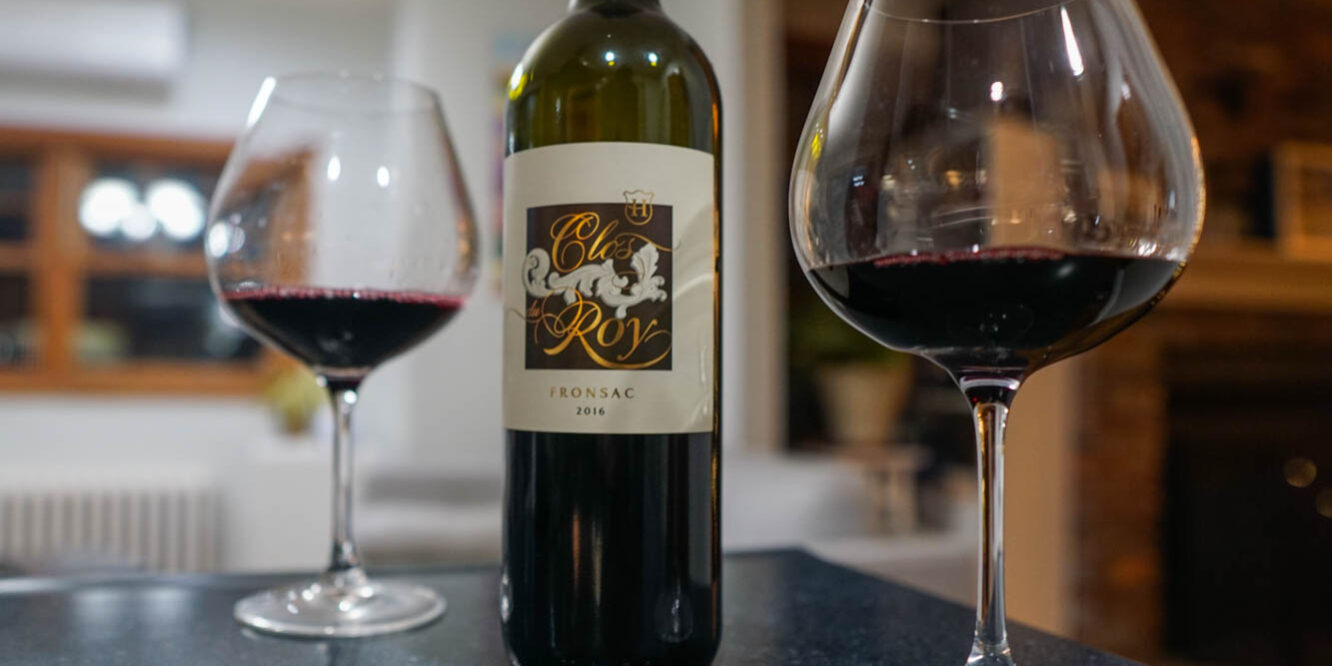May 2025 Red & White
Reds
Chateau Clos du Roy Fronsac, Bordeaux, 2020
This family-owned estate in Fronsac crafts wines that express the richness and complexity of their unique terroir. Fronsac vine estates stretch on hillsides overlooking the confluence of the Isle and the Dordogne rivers, this terroir of the Bordeaux area has been renowned for more than three centuries. The Clos du Roy is a family owned 22-hectare wine estate whose wines fully express the richness and the complexity of the greatest Fronsac vines. The Clos du Roy is naturally strong and prone to aging, its winemaking process is led by a constant care for balance and delicacy.
The 2020 vintage, a blend of Merlot (90%), Cabernet Franc (5%), and Cabernet Sauvignon (5%), aged in French oak, is deep, dark, and powerful. Aromas of black cherry, licorice, mocha, and sweet spices lead to a velvety texture and plush tannins, culminating in a long and savory finish. This wine offers exceptional value for its quality.
Bordeaux blends are a dream for food pairing. Red meats, especially grilled or roasted, like ribeye steak or lamb chops, are a classic match. Game meats such as venison or wild boar are also excellent choices. For poultry, roasted duck breast or chicken work well. Pork dishes, like tenderloin or chops, also complement the wine’s character. Beyond meats, Fronsac wines pair well with grilled vegetables like eggplant and zucchini. More refined pairings include foie gras and certain blue cheeses.
Product Ratings:
Decanter, 92 Points
“Limestone austerity comes through pretty strongly on the attack in the form of a slate and crushed stone texture, followed by plenty of freshly cut herbs and fairly subdued raspberry and blueberry fruit, with touches of richer and more mellow pie crust as it opens up. This is a classic well-balanced Fronsac with a ton of appellation typicity.”
James Suckling, 92 Points
“A juicy red with blackberry, chocolate and walnut aromas and flavors. Medium to full body. Round tannins. Chewy at the end. Needs time to soften.”
Wine Advocate, 92 Points
“Deep purple-black colored, the 2020 Clos du Roy leaps from the glass with vibrant notes of black cherries, baked plums and mossy tree bark, with wafts of wild mushrooms and chargrill. The medium to full-bodied palate delivers a rock-solid structure of grainy tannins and bold freshness to support the generous black fruit, finishing earthy.”
Bodega Noemia A Lisa Malbec, Patagônia, 2022
Bodega Noemia is one of the southern-most wineries in the world. A region of glacial origins with poor soil and limestone-rich bedrock, it benefits from the mineral-rich waters of the Limay and Neuquen rivers. First planted in 1932, the original pre-phylloxera rootstock of the vineyards was carefully resuscitated starting in 2001, and winemaker Hans Vinding-Diers oversaw the estate’d Massale selections in order to create tailored vineyard compositions. To amplify the terroir’s signature in the final wines, fermentation is carried out using only indigenous yeasts. Committed to protecting this unique patrimony, almost all Bodega Noemia wines are produced in accordance with Argencert organic and Demeter biodynamic standards.
Made up of 90% Malbec and 10% Merlot, this wine is fermented in stainless steel and macerated for 10 days, then aged in used barriques for 10 months, with an additional 3 months in bottle.
With its full body and fruity notes, this wine pairs exceptionally well with grilled meats, especially beef, lamb, and pork. It also complements richer dishes like hearty stews, barbecue, and savory cheeses like blue cheese and aged cheddar. For a unique twist, try it with dishes featuring earthy vegetables like mushrooms or roasted peppers.
Product Ratings:
Vintous, 93 Points
“A bright, purple-hued wine, it offers fresh plum and cherry on the nose, complemented by delicate lavender and herb undertones. Dry and moderately lean, fine-grained tannins and a juicy mouthfeel lead to a long- lasting, flavorful finish. This is an unusual red within the Argentine context.”
Whites
ERSOL Chardonnay, Sonoma Coast, 2021
ERSOL, meaning “air and sun” in Latin, pays tribute to the elemental influences shaping the Sonoma coast. Each bottle encapsulates the invigorating coastal breeze and radiant sunlight, creating wines of unparalleled depth and complexity. This project from world-renowned winemaker Joel Gott offers small-batch Chardonnay (and Pinot Noir) that celebrates the dynamic terroir of the Sonoma Coast appellation. Situated along California’s rugged Pacific coastline, the Sonoma coast is renowned for its cool, foggy climate and diverse terrain, creating optimal conditions for crafting premium wines.
Within the larger Sonoma Coast appellation, fruit from Nightwing Vineyard, planted in diverse soil types along the more than 1,000-foot elevations of the mountainous eastern ridge of the Petaluma Gap AVA experiences dense, morning fog followed by moderate afternoon winds from the nearby Pacific Ocean. The region’s cool climate stresses the vines, creating smaller, more concentrated fruit clusters that result in a more complex, fruit forward flavorful wine with balanced acidity, minerality and salinity.
On the palate, this wine opens with aromas of roasted pear, lemon custard and citrus with subtle notes of brûlée. On the mid-palate, soft tannins lead to refreshing acidity with flavors of toasted hazelnuts and baked apples followed by notes of cinnamon and brown sugar on a long, delicate finish.
This wine pairs well with seafood like salmon, shellfish, and even richer seafood like lobster. It also complements creamy pasta dishes, roasted poultry, and various cheeses, particularly mild, creamy varieties like Brie or Monterey Jack. Pro tip: avoid pairing it with spicy dishes, as the spice can overpower the wine’s delicate flavors!
Domaine Sick-Dreyer Riesling, Alsace, 2021
A family project from the start, this house traces its roots to 1563, with the first recorded tracing of the cultivation of the Kaefferkopf vine and the production of wine by the Sick family. In 1932, protection of the Kaefferkopf grape and its appellation area was announced by a decree of law- initiative launched by Joseph Dreyer, great-grandfather of current winemaker Etienne Dreyer. In 1966, Etienne’s father Pierre Dreyer joined forces with his uncle René Sick and founded the Domaine Sick-Dreyer in Ammerschwihr, France.
This is a fine, virile, and distinguished dry wine with exquisite fruit and a delicate bouquet, yet remains distinguished and fruity. On the palate, its liveliness, freshness, and multiple citrus aromas, including grapefruit, lemon, and lime, will seduce many.
This wine pairs excellent with seafood, poultry, and vegetarian dishes with light sauces. Riesling’s high acidity helps cut through rich or fatty foods, cleansing the palate, making it great for in-between courses as well.








